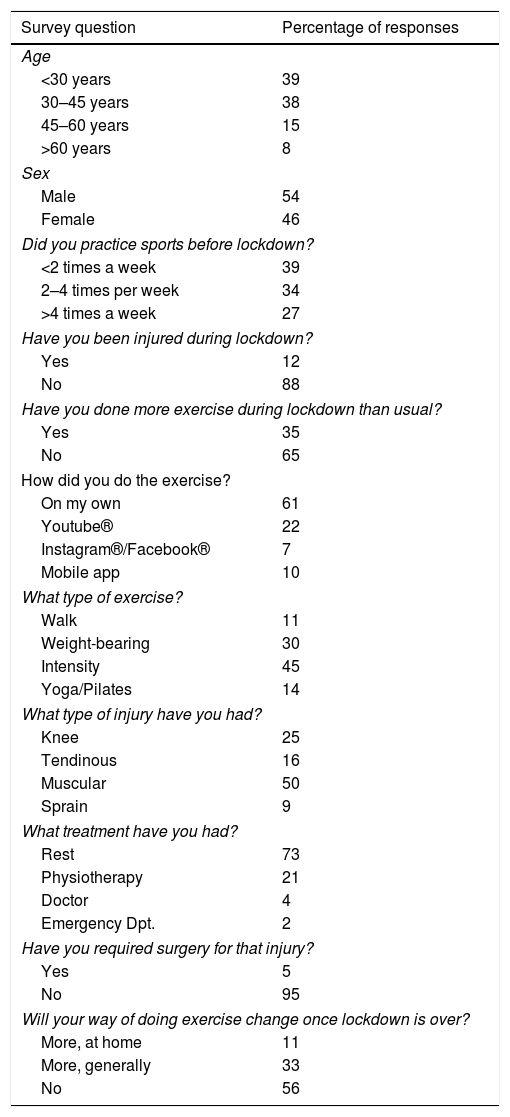Since the start of the coronavirus (COVID-19) outbreak in late 2019 in Wuhan, China,1 the pandemic has already affected more than 200 countries and millions of people worldwide.2 The main world governments have decreed mandatory lockdowns and social distancing, increasing sports activity at home, which is often done incorrectly and leads to injuries.3
Taking advantage of the current massive use of social networks, we carried out a survey in one of them (Twitter®) seeking to find out the characteristics of the musculoskeletal injuries that are currently occurring during lockdown.
The main author through his Twitter account® @drlopezmartinez with more than 10,200 followers, carried out a free access survey from 14th to 21st of April 2020. A survey of 11 multiple-choice close-ended questions, aimed at obtaining information on musculoskeletal injuries in the current lockdown (Table 1) was completed by 1902 people.
Eleven questions from a survey conducted via Twitter® with percentage of responses.
| Survey question | Percentage of responses |
|---|---|
| Age | |
| <30 years | 39 |
| 30–45 years | 38 |
| 45–60 years | 15 |
| >60 years | 8 |
| Sex | |
| Male | 54 |
| Female | 46 |
| Did you practice sports before lockdown? | |
| <2 times a week | 39 |
| 2–4 times per week | 34 |
| >4 times a week | 27 |
| Have you been injured during lockdown? | |
| Yes | 12 |
| No | 88 |
| Have you done more exercise during lockdown than usual? | |
| Yes | 35 |
| No | 65 |
| How did you do the exercise? | |
| On my own | 61 |
| Youtube® | 22 |
| Instagram®/Facebook® | 7 |
| Mobile app | 10 |
| What type of exercise? | |
| Walk | 11 |
| Weight-bearing | 30 |
| Intensity | 45 |
| Yoga/Pilates | 14 |
| What type of injury have you had? | |
| Knee | 25 |
| Tendinous | 16 |
| Muscular | 50 |
| Sprain | 9 |
| What treatment have you had? | |
| Rest | 73 |
| Physiotherapy | 21 |
| Doctor | 4 |
| Emergency Dpt. | 2 |
| Have you required surgery for that injury? | |
| Yes | 5 |
| No | 95 |
| Will your way of doing exercise change once lockdown is over? | |
| More, at home | 11 |
| More, generally | 33 |
| No | 56 |
Of the total of 1902 people surveyed, the vast majority were under 45 years of age (77%).
Twelve percent of the respondents had a musculoskeletal injury during lockdown (228 patients), with 35% doing more sports during lockdown than usual.
Sixty-one percent exercised on their own, the rest (39%) report having used apps or social networks to guide their physical activity, being YouTube® (22%) the most used.
The most popular type of exercise was intensity-related (45%), consisting of high-intensity exercises and repetitions in a short time interval (CrossFit®Hiit® and Tabata®), followed by weight-bearing exercises (30%), and finally Yoga/Pilates (14%) and walking (11%).
Regarding injuries, 50% were muscle injuries, 25% knee injuries, 16% tendinopathies and 9% sprains. The most widely used treatment has been conservative treatment using rest, NSAIDs and local cold application (73% of cases), highlighting that 32 patients (5%) have required surgical treatment.
The author of the survey personally verified that many of the injuries derived from playing sports in the hallway of their homes, with repeated knee twists and related injuries (especially meniscus), which he called the “Hallway syndrome”. It should be noted that challenges have been posted on social networks related to marathons (42 km) and even 100 km races at home, with all the implications that these may have.
An overwhelming majority of respondents (61%) were physically active on their own; of those, possibly a high percentage performed activities randomly and rigorously, which would not only be ineffective, but could expose them to injury. The same risk would be taken by the rest of the respondents who use YouTube® and social networks to do exercises, which are recommended on a non-individual basis. And much worse still, many of the Influencers in these networks do not have professional qualifications to recommend physical exercise.
Most of the respondents carried out intensity (45%) and weight-bearing (30%) exercises, all this added to the above mentioned scenario results in a population vulnerable to physical injuries, in fact 12% of the respondents have already suffered from some type of lockdown-related injury, and even 5% have ended up requiring surgical treatment.
This study has limitations, it is an Internet survey, which therefore does not allow reliable statistical estimates to be made with the results. We also admit the impossibility of determining the exact injury of the patients, since many of these knee injuries (25% of injured) may require elective surgery once the lockdown has ended. We also do not know of those 5% of cases that have required surgery exactly what type it has been.
Perhaps the great strength of this study is that it deals with a subject of great current interest, and which seeks to alert the public and the authorities about not simplifying physical activity at home.
The current lockdown can increase the rate of psychic disorders, with sport being an essential prevention tool. The recommendation is to do at least 30 min of moderate intensity physical activity daily,3–5 ideally through individualized advice from specialists in the field.
FundingThe authors of the article do not have direct or indirect funding for this study.
Please cite this article as: Lopez Martinez JJ, Rodríguez-Roiz JM, Salcedo Cánovas C. Lesiones musculoesqueléticas secundarias al ejercicio durante el confinamiento por la pandemia COVID-19. Med Clin (Barc). 2020;155:221–222.







